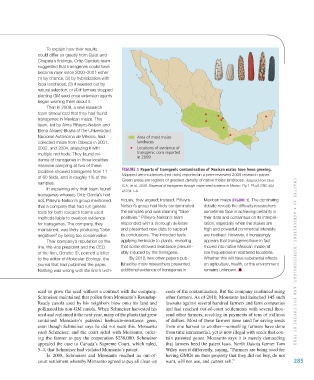Page 286 - Environment: The Science Behind the Stories
P. 286
To explain how their results
could differ so greatly from Quist and
Chapela’s findings, Ortiz-García’s team
suggested that transgenes could have
become rarer since 2000–2001 either
(1) by chance, (2) by hybridization with
local landraces, (3) if weeded out by
natural selection, or (4) if farmers stopped
planting GM seed once extension agents
began warning them about it.
Then in 2009, a new research
team announced that they had found
transgenes in Mexican maize. This
team, led by Alma Piñeyro-Nelson and
Elena Álvarez-Buylla of the Universidad
Nacional Autónoma de México, had Area of most maize
collected maize from Oaxaca in 2001, landraces
2002, and 2004, analyzing it with Locations of evidence of
multiple methods. They found evi- transgenic corn reported
dence of transgenes in three localities. in 2009
Intensive sampling at two of these
localities showed transgenes from 11 Figure 1 reports of transgenic contamination of Mexican maize have been growing.
of 60 fields, and in roughly 1% of the Mapped are incidences (red dots) reported in a peer-reviewed 2009 research paper.
samples. Green areas are regions of greatest density of native maize landraces. Adapted from Dyer,
In explaining why their team found G.A., et al., 2009. Dispersal of transgenes through maize seed systems in Mexico. Fig 1. PLoS ONE 4(5)
transgenes whereas Ortiz-García’s had e5734:1–9.
not, Piñeyro-Nelson’s group mentioned niques, they argued; instead, Piñeyro- Mexican maize (Figure 1). The continuing
that a company that had run genetic Nelson’s group had likely contaminated debate reveals the difficulty researchers
tests for both research teams used the samples and was claiming “false sometimes face in achieving certainty in
methods liable to overlook evidence positives.” Piñeyro-Nelson’s team their data and consensus on its interpre-
for transgenes. The company, they responded with a thorough defense tation, especially when the stakes are
maintained, was likely producing “false and presented new data to support high and powerful commercial interests
negatives” by being too conservative. its conclusions. This included tests are involved. However, it increasingly
Their company’s reputation on the applying herbicide to plants, revealing appears that transgenes have in fact
line, the vice president and the CEO that some showed resistance presum- moved into native Mexican maize, at
of the firm, Genetic ID, penned a letter ably induced by the transgene. low frequencies in scattered locations.
to the editor of Molecular Ecology, the By 2010, two other papers pub- Whether this will have substantial effects
journal that had published the paper. lished by more researchers presented on agriculture, health, or the environment CHAPTER 10 • A g R i C ulT u RE , Bi o TECH nology, A nd THE Fu T u RE o F Food
Nothing was wrong with the firm’s tech- additional evidence of transgenes in remains unknown.
seed or grow the seed without a contract with the company. costs of the contamination. But the company continued suing
Schmeiser maintained that pollen from Monsanto’s Roundup- other farmers. As of 2010, Monsanto had launched 145 such
Ready canola used by his neighbors blew onto his land and lawsuits against several hundred farmers and farm companies
pollinated his non-GM canola. When Schmeiser harvested his and had reached out-of-court settlements with several thou-
seed and replanted it the next year, many of the plants that grew sand other farmers, resulting in payments of tens of millions
contained Monsanto’s patented herbicide-resistance gene, of dollars. Most of these farmers were sued for saving seeds
even though Schmeiser says he did not want this. Monsanto from one harvest to another—something farmers have done
sued Schmeiser, and the court sided with Monsanto, order- from time immemorial, yet is now illegal with seeds that con-
ing the farmer to pay the corporation $238,000. Schmeiser tain patented genes. Monsanto says it is merely demanding
appealed the case to Canada’s Supreme Court, which ruled, that farmers heed the patent laws. North Dakota farmer Tom
5–4, that Schmeiser had violated Monsanto’s patent. Wiley sees it differently, saying, “Farmers are being sued for
In 2008, Schmeiser and Monsanto reached an out-of- having GMOs on their property that they did not buy, do not
court settlement whereby Monsanto agreed to pay all clean-up want, will not use, and cannot sell.” 285
M10_WITH7428_05_SE_C10.indd 285 12/12/14 2:59 PM

